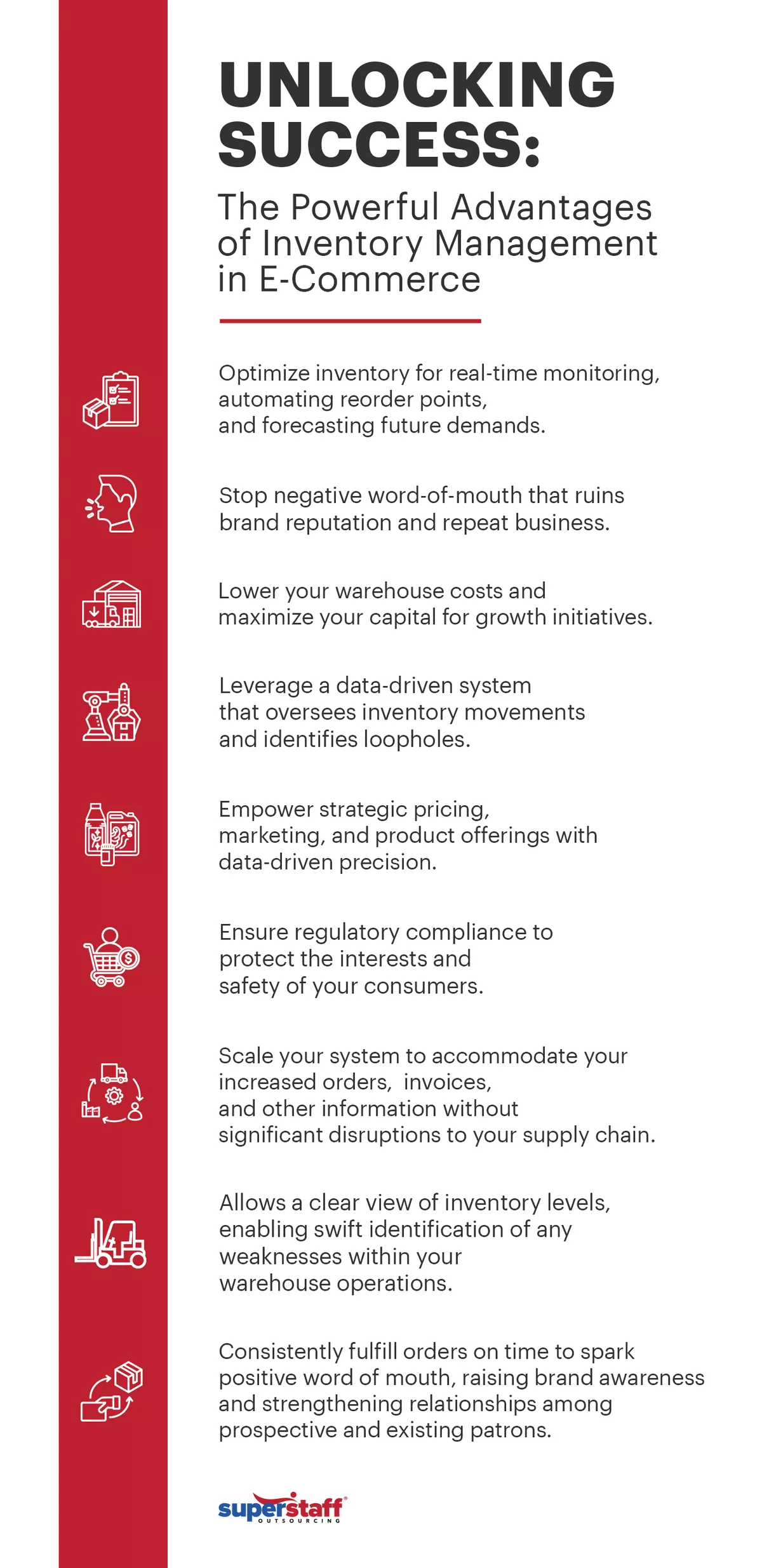
Let’s say you’re a retail company competing with company X, which offers the same product and services at the same rates. But there’s one crucial difference. Company X consistently delivers on time while your company struggles to do so.
This scenario makes it abundantly clear which company is more committed to customer satisfaction.
No matter how experienced you are in e-commerce, timely delivery is crucial. An equally efficient inventory management system is the key to a streamlined dispatch system. Before we delve deep into the strategies that ensure the efficient management of inventories, let’s first understand what it is.
What Is Inventory Management?
In the logistics business, few things are more disheartening than explaining to customers why their packages are delayed. You want to avoid late deliveries and keep your customers as satisfied as possible.
But how can you achieve this? By optimizing your e-commerce inventory management systems.
This business strategy lets you identify stock levels across multiple sales channels, ensuring your company has sufficient goods for future orders. It tracks inventory, beginning from the purchase to the sale of items. When your inventory is well-organized, your supply chain management immediately falls into place. What’s more, you better understand your logistics and analytics.
Mistakes such as shortages, spoilage (for perishable goods), mis-shipments, overstocking, and late deliveries become inevitable without a proper inventory management system.
The Advantages of Inventory Management in E-Commerce
Effective inventory management isn’t just about maintaining stocks; it fundamentally influences your e-commerce business growth, stability, and customer satisfaction.
Unfortunately, many businesses still use manual inventory management methods, often resulting in human errors. These mistakes cloud the visibility and transparency of your inventory flow, causing unexpected immobility and unavailability of stocks — damaging customer relationships and your bottom line.
Explore how innovative e-commerce inventory management systems help businesses avoid late deliveries and ensure maximum customer satisfaction.
Optimized Stock Levels
Successful sales hinge on three fundamental principles:
- Tracking your inventory movement.
- Knowing who your customers are.
- Understanding where your items need to be.
➡️40% Off Operational Cost? Find Out First Now
With these three things in check, you can easily anticipate the required stock volume, helping you strike a balance between demand and supply to avoid hefty storage fees. Implementing techniques to optimize inventory, such as employing inventory technology for real-time monitoring, automating reorder points, and forecasting future demands, proves invaluable in this endeavor.
Neglecting these practices might lead to insufficient stock levels, resulting in increased missed sales, backorders, and customer dissatisfaction. Conversely, excessive inventory can lead to a surplus of “dead stock,” often due to items expiring, becoming obsolete, going out of season, or declining quality.
Improved Customer Satisfaction
A 2020 survey revealed that small and medium-sized enterprises (SMEs) with systematic inventory management could deliver 52% of their shipments on time, compared to only 40% for SMEs with inefficient inventory management.
In other words, companies neglecting their inventory management will face more dissatisfied customers. With customer expectations at an all-time high, they will share their sentiments online, posing a significant risk to your brand reputation and potential repeat business.
Word-of-mouth spreads swiftly, and its credibility and trustworthiness often hold more weight than other forms of communication. Your business might face enduring damage to its image, which could prove challenging to rectify even with abundant positive testimonials.
Cost Savings and Financial Efficiency
Your inventory can either make or break your bottom line. Sticking to poor stock management will put your inventory supply chain to a standstill and trigger severe revenue losses.
Relieve yourselves from this financial nightmare by investing in a quality inventory management system. Doing so allows you to enforce a meticulous fulfillment approach, whether it’s first in, first out (FIFO), last in, first out (LIFO), or first expired, first out (FEFO). Let’s delve into each of them:
- FIFO: Sells old items first to reduce the risks of dead stock
- LIFO: Sells new items first, as old items are deemed worthless and obsolete
- FEFO: Sells items with the earliest expiration date first to avoid severe financial losses
These strategies will lower your warehouse costs and enable you to leverage your capital for growth initiatives.
Enhanced Operational Efficiency
Stockouts and excess inventory are bottlenecks in your operations. You can overcome these issues with a data-driven inventory system to oversee movements and identify loopholes. This helps you maintain optimal inventory levels to avoid revenue loss.
Since your inventory decisions hinge on your customer demands, making projections based on data is imperative, especially during seasonal fluctuations. But while estimating market trends is nearly impossible, you can at least discover which of your products will spike in demand. Here are two forecasting models for you to enhance your operational efficiencies:
- Quantitative Forecasting: Uses past sales data to forecast future demands
- Qualitative Forecasting: Refers to market research, customer reviews, or instinct to predict upcoming trends
Better Decision-Making
Visibility across all operations is critical in making the right decision. By leveraging insights from your inventory reports, you can empower strategic choices regarding pricing, marketing, and product offerings with data-driven precision.
Consider a scenario where you aim to introduce new products to your company but hesitate due to the fear of overstocking. Utilizing your detailed reports allows for contextualizing data and conducting thorough analyses of product performance. This in-depth understanding enables fine-tuning marketing strategies, such as replacing slower-moving items with newer, potentially more appealing products.
Stronger Supplier Relationships
While most leaders (70%) think they know their supplier risks, only 26% had accurate predictions.
This stark disparity serves as a wake-up call for businesses to strengthen their relationships with suppliers, a critical component in delivering clear visibility throughout your supply chain. Establishing robust relationships with suppliers facilitates seamless communication regarding availability issues, delays, and quality concerns. This insight empowers businesses to devise contingency plans, effectively mitigating potentially unfavorable outcomes.
Enhancing inventory management is the most effective means to foster healthy ties with suppliers. Through adept inventory management, businesses gain insights into what to stock and when providing early warnings of potential shortages. This proactive approach eliminates the need to pressure suppliers for urgent stock replenishments. When a strong rapport exists, businesses may access perks such as preferential treatment, discounted prices, and enhanced operational stability, fostering mutually beneficial partnerships.
Compliance and Accuracy
A mandatory aspect of proper inventory management is regulatory compliance, ensuring that you’re protecting the interests and safety of your consumers.
Say you’re a stakeholder in a healthcare facility. Mixing up medical supplies can result in prescription errors and pose severe risks to patients’ lives. There’s no room for poor inventory management in the healthcare world.
Fortunately, inventory management systems feature accurate tracking. It comes equipped with functions like barcode and RFID tag scanning, ensuring your records are up-to-date, consistent, and error-free. As a result, you can efficiently organize inventories based on classifications, such as segregating perishables from controlled substances, contributing to a safer and more regulated inventory management process in healthcare settings.
Scalability and Growth
During the start-up phase of your business, you need to channel your attention toward developing sustainable business models. But once you’ve conquered this first hurdle, it’s time for you to expand your markets and strategically foster lasting customer relationships.
As your business grows, your inventory management system needs to mature with you — which is precisely why a scalable inventory management system matters.
A scalable system can accommodate your increased orders, invoices, and other information without significant disruptions to your supply chain. Regardless of the size of your business, this system can provide real-time inventory counts and updates, guiding you on the inventory required to fulfill customer orders.
Risk Mitigation
Inventory risks, such as obsolete goods, reduced quality, or delayed deliveries, often result in significant disruptions that impede other facets of your business.
However, a robust inventory management system can serve as your stalwart ally in mitigating these risks. The insights provide a clear view of inventory levels, enabling swift identification of any weaknesses within your warehouse operations. With this visibility, proactive measures can be promptly taken to address and resolve potential issues before they escalate.
Competitive Edge
Comprehensive inventory management is closely linked to business success. When you consistently fulfill orders on time, it sparks positive word of mouth, raising brand awareness and strengthening relationships among prospective and existing patrons. With this competitive advantage already locked in, you finally secure your cash flow amid these uncertain times.
10 Strategies To Improve Inventory Management in E-Commerce
Your inventory can be your greatest asset or your biggest downfall, depending on how you manage it.
This is why inventory management lies at the heart of successful e-commerce operations. With a few tweaks, you can predict your future sales, secure your bottom line, and stay on the radar of businesses seeking a reliable logistics partner.
So, what are the best practices to elevate your inventory management to new heights?
Real-Time Inventory Tracking Systems
Imagine losing a done deal just because you don’t have sufficient stocks. Not only will this adversely impact your immediate sales, but it will also affect your future sales from the same client.
This is why you can’t afford to rely on manual inventory updating — a method prone to human error that only provides periodic updates. It would help if you had inventory management software that automates the ins and outs of your stocks, giving your clients up-to-the-minute updates on your inventory data and eliminating risks across all sales channels.
➡️How Do I Start With My Outsourcing? Book A Free Call
With this accurate and transparent view of your inventory, you can flawlessly deliver customer purchases on the dot, cultivating positive experiences and repeat business.
Demand Forecasting
The old mantra, “inspect what you expect,” still stands true in e-commerce. Achieving accurate stock quantities necessitates employing sophisticated inventory forecasting methods like demand forecasting.
Building upon historical sales data and current market trends forms the bedrock of precise demand forecasting. By conducting predictive analyses based on this information, businesses can anticipate their customers’ future demand for products or services. This foresight empowers them to make more informed and strategic supply decisions.
ABC Analysis
Undoubtedly, most e-commerce businesses thrive from outstanding inventory management, so ABC inventory (or the “80/20” rule) has become popular among leading companies.
ABC inventory is a technique that categorizes stocks based on their return on investment. This guides leaders in understanding which products are pivotal to their financial success. In other words, ABC inventory helps businesses allocate more resources to products with higher turnover rates to avoid stockout.
Let’s break down these categories:
- Group A: Generate 80% of your sales but constitute 20% of your stock (high-value, low-quantity)
- Group B: Generate 15% of your sales and include 30% of your stock (moderate-value, moderate-quantity)
- Group C: Generate 5% of your sales but comprise 50% of your stock (low-value, high-quantity)
Supplier Relationship Management
The relationship between you and your supplier is a two-way street. You purchase their raw materials and goods, and they add value to your company.
But how can you ensure the relationship is mutually beneficial? It is by implementing a supplier relationship management (SRM) system.
The key to success here is symbiosis. An effective SRM strategy evaluates all vendors, categorizing them based on their impact on your success. Once identified, you can nurture these supplier relationships accordingly, ensuring the most valuable ones remain closely connected and engaged in your business operations.
Just-In-Time (JIT) Inventory
The Just-in-Time (JIT) inventory method is a go-to strategy for newcomers in the e-commerce realm. This approach focuses on maintaining minimal inventory levels, reducing holding costs, and ensuring high product quality.
Restaurants serve as a prime example of businesses that effectively employ JIT. In the food and beverage (F&B) industry, establishments order supplies only when their stock runs low, minimizing the risks associated with product wastage and maintaining a lean, efficient inventory system.
Implement SKU Standardization
Picture this: Gina, your online customer, is ordering an outfit from your online retail store. She soon realizes her size has run out as she browses the catalog. To be sure, she connects with your customer support team and asks about the item’s availability.
However, your brand fails to codify each product. You’re forced to search for the stock manually for days — and voila, Gina’s size is indeed available. But sadly, she has already bought the outfit from your direct competitor.
You could’ve secured a sale if only you had approached her sooner. So, how can you avoid this? By enforcing the Stock Keeping Unit (SKU) standardization.
SKUs are unique identifiers that label each product based on various criteria, such as color, type, size, and manufacturer code. By leveraging consistent SKU formats across your system, you can track your inventory levels with just a few clicks on your monitor.
Regular Audits and Cycle Counts
Typos in data entry can occasionally occur, and even minor inconsistencies between your digital records and physical stocks can lead to erroneous inventory counts, disrupting the efficiency of your business operations.
Fortunately, there’s a remedy for these discrepancies through regular audits and cycle counts. Cycle counting involves systematically tallying the number of items within specific categories. The count’s outcome is a reference point, allowing comparison with the data stored in your digital records.
This process is repeated across various subsets of your inventory according to a scheduled routine. Ultimately, it helps reconcile and rectify discrepancies between physical inventory and recorded data.
Optimize Warehouse Layout and Processes
Industry experts emphasize that the potential profits often lie within your warehouse. Therefore, overlooking the layout of your warehouse could be detrimental. A poorly designed layout typically results in increased labor expenses, overflow of stock, and limited storage capacity — costs that could have been allocated to activities generating revenue.
Conversely, an optimized warehouse layout can significantly enhance productivity and efficiently utilize resources, facilitating the smooth flow of goods within the space. One effective strategy involves positioning high-demand items close to shipping areas. Additionally, systematic organization of workstations helps minimize wasted space, contributing to an overall more efficient operation.
Monitor and Analyze Metrics
Hoarding excessive stock can escalate storage expenses and tie up cash flow while having too little stock might result in unmet sales potential. Striking a balance between these two extremes is vital for businesses.
Introducing Key Performance Indicators (KPIs) in inventory management can help achieve this equilibrium. KPIs allow for the monitoring, measuring, and evaluating performance, offering valuable insights to optimize stock levels and eradicate guesswork. These metrics track progress, pinpoint weaknesses, and unveil potential opportunities. Some of the common KPIs include:
- Inventory Accuracy: Measures the inconsistencies between your inventory records and your physical stocks
- Inventory Turnover: Tallies the number of times a company has sold and replaced within a specific period
- Sell-through Rate: Calculates the amount of goods sold vis-a-vis the amount of goods received within a standard period
- Safety Stock: Indicates the excess product quantity stored in the warehouse to avoid stockouts
- Lead Times: Records the average time taken for a restock between the time of the order to when it’s received
Leverage Inventory Management Outsourcing
Digitalization has transformed e-commerce into a growing force in the modern economy, accelerating its popularity at an unprecedented rate. In 2022, the e-commerce market experienced an exponential hike during the holiday sales, with customers spending:
- $11.3 billion on Cyber Monday
- $9.12 billion on Black Friday
By 2025, 22.2% of retail sales will come from online transactions, surpassing $7 trillion. With so much revenue on the line, elevating operational efficiencies must be at the forefront of your business strategy to ease shopping processes and boost customer experience.
This is how inventory management outsourcing nurtures your e-commerce business. It will streamline your operations and enable you to offload massive work volumes and focus on your core competencies cost-efficiently. Several aspects of inventory management can be outsourced, such as:
- Inventory Tracking and Control: Offers real-time inventory tracking, ensuring accuracy and minimizing stockouts or overstock situations.
- Order Fulfillment: Upgrades shipping, packaging, and delivery processes, enhancing customer satisfaction and reducing shipping costs.
- Warehousing Management: Coordinates workflow within the warehouse, ensuring the facilities are operated efficiently.
- Technology and Software: Specialists are trained in handling inventory management software and systems tailored to e-commerce needs, reducing the hassle of in-house training and development.
- Forecasting and Analytics: Provides analytics and forecasting services to predict demand patterns, optimize inventory levels, and avoid stock shortages.
Optimize Your Inventory Management Today: Streamline Your E-commerce Success
➡️Curious About SuperStaff’s Most Common Outsourced Roles? Talk To Us
Keeping a watchful eye on your inventory is critical to achieving entrepreneurial success, regardless of the business size. As the marketplace becomes more cutthroat, it’s wise for businesses to begin assessing their internal business processes — and part of that is identifying potential inventory challenges and resolving them head-on.
So, get your inventory management journey started with SuperStaff.
Our goal is simple: providing inventory management solutions tailored to your business goals and needs. We’re dedicated to guiding you step by step with the perfect tactics, paving the way for better business decisions, warehouse management, and inventory count visibility.
Revolutionize your inventory management plan today!








